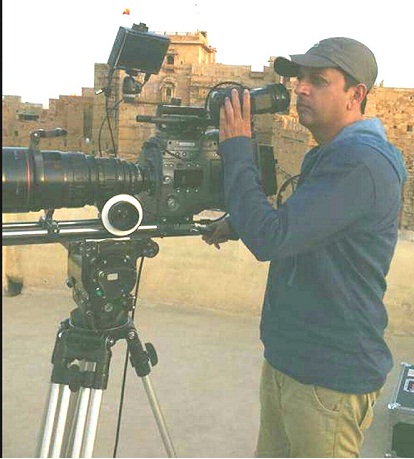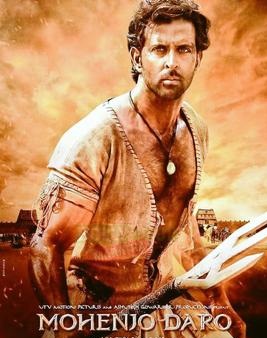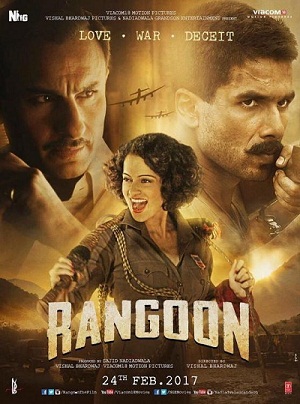
Let’s do a flashback when our film industry had only special effects and this doyen belonged to the industry since those times. Yes, we are talking about VFX supervisor Govardhan Vigraham who has seen the visual effects industry in India grow yard by yard. This connoisseur has films like Haider, Fitoor, Rangoon, Cocktail, Mohenjo Daro and many more under his belt. He has also won the Filmfare Best Special effects award for Kaminey in 2010.
Recently working with Drishyam VFX on Rangoon and Mohenjo Daro has been a refreshing experience for Vigraham. AnimationXpress gets in touch with the visual effects specialist to get more insights from the genius man.
Tell us about yourself. What attracted you to the VFX field?
Govardhan : Computer graphics was my primary attraction and when I pursued it back in early 90s, it was a tool used solely in TV commercials. I got into it by working for a production house that specialised in CGI based TV commercials. I then went on to direct a few commercials and music videos and made extensive use of CGI.The term VFX was not yet born around that time, at least not in India, but eventually came up when feature film guys started demanding CGI effects.
Being in the industry for more than 20 years, you have witnessed a paradigm shift. How has the journey been?
Govardhan : This has been one industry that has seen a tremendous growth and transformation, especially in the last decade. The growth is both in terms of technology and resources. There’s more talent available now than ever before, with artists seeing measurable career growth, both monetarily and roles they play. It is now a much organised and recognised industry, with a growing investor trust and knowledgeable clients.Scripts are better written these days, and there is more scope for the technical hands to contribute, not only VFX but also other departments like camera, stunts, art, miniature makers, sound et cetera.
Personally, I find myself now in a space that’s more relaxing since we now have filmmakers who have a much deeper knowledge, at least on the fundamental capabilities if not in depth, and that makes my job more enjoyable, allows me to concentrate a bit more on the creative side, which is where the fun really is.
Which projects are close to your heart?
Govardhan : Many of the last few projects have been enjoyable. It is difficult to single out anything in particular.
Which has been the most challenging project?
Govardhan : A few projects I most recently handled come to my mind – Mohenjo Daro and Rangoon. Challenging because of the tough deadlines combined with some really big effects shots to execute. The water in Mohenjo Daro was really challenging since we had to digitally create water for practically every shot in the entire climax, except for some shots in which we had some minimal live water layers. In Rangoon, the entire bridge sequence in the interval and climax was all VFX with each shot involving numerous layers of live and CG trees, plants, bridge, VFX etc. Getting them to look consistent so they maintained proper continuity was a huge task – both personally for me, and the VFX team at Drishyam.

What are the key things a VFX supervisor needs to keep in mind while accepting and delivering a project?
Govardhan : The first thing I always ask is to be given the script as early as possible. This lets me sink into the story, the treatment, and blend in with the creative process.
Next, I will focus on what the director’s vision is, mainly, if he/she has a clear vision in the first place. The last thing you want is ambiguity and vague ideas on what is expected.
Then, I would like to know the budget and deadline – if there is a deficit in both or even in either of these two, we are in trouble.
How do you handle creative differences with the director?
Govardhan : Creative people always have some form of differences. The challenge is in how you get to work together, and be able to communicate your thoughts as objectively, and clearly as possible. You have to realise that the VFX guy has to blend with the director and the other creative brains who will eventually come together to make the film. There are no definite guidelines or do’s and don’ts here. I just try to focus as much as possible on issues that directly concern me. Of course, in time, you build relationships and comfort levels with directors you’ve worked with before, and this enables you to open up a little more. There have been many instances when I have made my point understood in matters that went beyond VFX, but only because I was absolutely confident I was making sense, and because I had won the trust of the maker.
Being an industry veteran, what kinds of projects entice you?
Govardhan : Projects where VFX as a tool lets you help tell the story are what I would pick. I personally dislike using such a beautiful art that VFX is for gimmicks – I’ve actually turned away projects where I could see it being used for ridiculous reasons, like maybe some gaudy song sequences, or atrociously designed stunt sequences. I’ve enjoyed the privilege of being selective in the last five years on what I would like to be personally associated with.
Recently, you delivered two projects: Mohenjo Daro and Rangoon. Why did you choose Drishyam VFX? How was the experience working with the studio?

Govardhan : Prior to these two projects, the team had delivered another milestone project – Fitoor. In fact, the head of the team, Rajeev had earlier handled many of my earlier projects, and I always felt confident and comfortable handing over shots to his team.
Mohenjo Daro and Rangoon needed some serious attention – both in planning and execution. This involved knowing in advance what kind of technological and artist level challenges Drishyam was going to face. I sat down with Rajeev and ensured he understood what I was looking at, and what the director was expecting. By the time the shots came up for execution, the team and technology was already in place.
You have worked with many studios in the past. Drishyam being a young studio, what do you think about the team? How different are they from other studios?
Govardhan : If there has been one studio where I’ve been absolutely confident and relaxed in execution, it’s Drishyam VFX. I’ve had quite a vast and varied experience over the years of working with various VFX facilities, but somehow I always felt a great deal of stress in other facilities. Either the team was not delivering, or the ownership was indifferent, or a deadly combination of both. At Drishyam, you get this sense of involvement, and a desire to be proactive to ensure smooth and efficient delivery.
Why did you decide to become a freelance VFX supervisor?
Govardhan : When I realised that being part of a facility was limiting my access to talented artists and technology, I decided to go independent. I had the opportunity to work with multiple facilities and provide that as an advantage to the producer so he/she could get quality work for the best of prices.
Which projects are you currently working on?
Govardhan : Over the last several months, I had actually been more involved in developing my own scripts, and I also made a short film which took much of my time. Consequently, I’ve now limited the number of projects I work on; so I now have Abhishek Kapoor’s Kedarnath and a Marathi film Zapatlela 3 by Mahesh Kothare, which is a sequel to a film I had worked on earlier.
How important it is for VFX artists to stay abreast with technological advancements?
Govardhan : Technology is growing at an astronomical pace now than ever before. In the past, say a decade ago, you had time to absorb new development, like when new software is introduced. But these days you have something new being announced practically every week! The trouble is you need to find time to learn the new tools and to execute work that you’re committed to deliver. If you are laid back or resistant to absorbing the newer advancements, then you get left behind, obsolete, and probably a loner. However, what I sorely miss is the fun we had in the past, where the technology did little, and it was more of artistic skills that did the job. You had to innovate a lot more, sleep a lot less nevertheless, but at the end, you had this euphoric feel when you created something that seemed impossible. These days, you still have a lot of fun, but it’s kind of more technical.
Govardhan : The technicians have proven their skills. It’s entirely up to the screen writers and directors. I guess that’s where we are headed. More creative writing, more knowledgeable writing, more trusting producers and a healthier environment than ever before.
How can a fruitful collaboration take place between the filmmakers and VFX houses?
Govardhan : Knowledge and trust. The filmmaker has to start looking at VFX as a tool that helps his/her films achievable. The VFX facility has to come in as a creative partner and not just as a business house interested in the money. Of course, finances matter, but the intent has to be to provide creative services first. The thing that a producer hates most is an indifferent VFX facility that distances itself from commitment and involvement.I think time has come for a bigger collaborations between the two, possibly explore opportunities in joint content ownership.
What is stopping the Indian VFX industry from being on par with the global giants? How can this scenario be changed?
Govardhan : I definitely don’t believe there’s any dearth here. India today is definitely on par on many departments within VFX. International projects get delivered right out of here. What we lack today is custom development. We lack R&D teams that can create custom effects for specific purposes. We rely more on off-the-shelf tools, and I think the blame is primarily at the script level. We hardly have scripts that demand investments in matters such as research and development. For example, we simply never felt the need to have a coding team that would create tools for say, sub-surface lighting. Our scripts barely test our capability. So whatever we have today in terms of technology is courtesy international work.
I feel a lot depends on the scripts. Although the writers today are better exposed than say a decade ago, there’s still a long long way to go.
